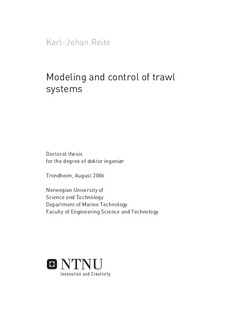Modeling and Control of Trawl Systems
Doctoral thesis
Permanent lenke
http://hdl.handle.net/11250/237617Utgivelsesdato
2006Metadata
Vis full innførselSamlinger
- Institutt for marin teknikk [3397]
Sammendrag
This thesis is motivated by the possible benefits of a more precise trawl control system with respect to both environmental impact and fishing efficiency. It considers how the control performance of a pelagic trawl system can be improved, partly by introducing a control architecture tailor-made for the trawl system subject to industrial requirements, and partly by developing a trawl door control concept.
A mathematical model of the trawl system is developed, including an accurate model of the hydrodynamic forces on the trawl doors. This model estimates both the steady state and the transient forces on trawl doors moving in six degrees of freedom. The steady state hydrodynamic forces are based on wind tunnel experiments. To estimate the transient forces, a software code based on potential theory is developed. This software estimates the time-dependency of the forces from circulation about the foil, the angular damping forces, and the forces from relative accelerations between the fluid and the trawl door.
Various concepts for trawl door control are evaluated. This is done both analytically, by simulations and by towing tank experiments. Based on the results, a new trawl door control concept is proposed. The trawl door control concept is developed to fulfill the demands on both energy consumption, robustness and control performance. Because of the contradictory demands on performance, stability and energy efficiency, the control concept is improved using numerical optimization. The optimization is based on timedomain simulations of the trawl system.
The design of an overall trawl control architecture taking advantage of the trawl door control system is presented. This takes industrial constraints into account, such as the energy supply on the trawl doors. The control system is based on model predictive control and facilitates complex objectives, constraints and process models. The use of model predictive control is made possible by letting PID plant controllers act as a layer between the model predictive controller and the trawl system. The model predictive controller is thus able to operate on a stable and predictable system with no fast dynamics. To reduce the energy consumption of the trawl door, conventional feedback control is avoided on this part of the control system, and step wise feedforward control is instead employed.
The main contributions in this work are the mathematical modeling of the hydrodynamic forces on a trawl door, the design of a control architecture tailor-made for trawl system control and the method for optimization of the trawl door control concept.
